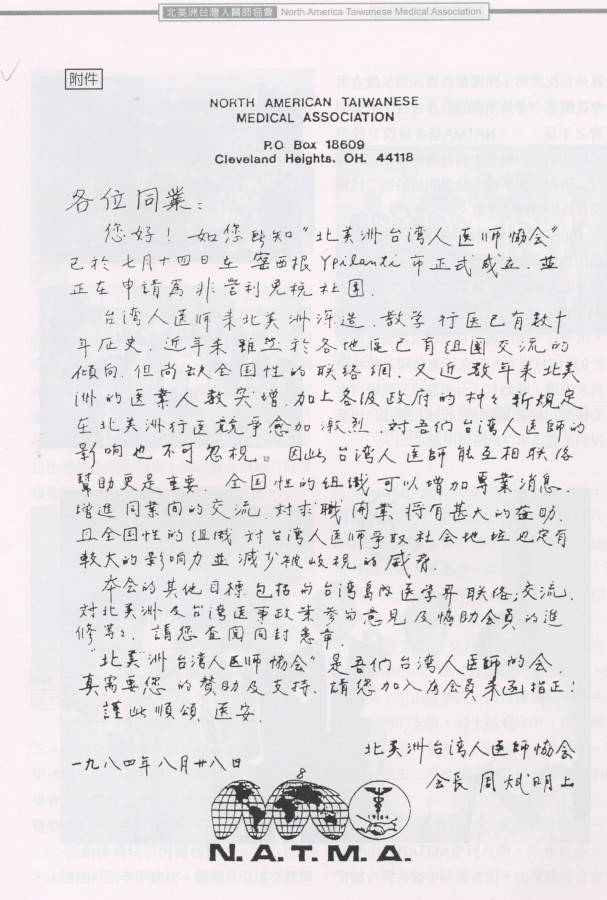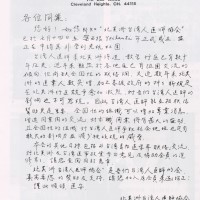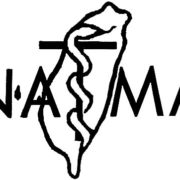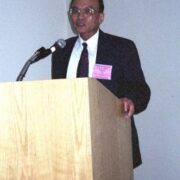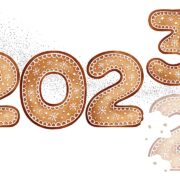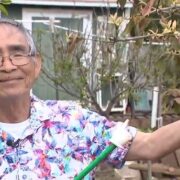The North American Taiwanese Medical Association, 1983 to 1990
Authors: Suy-Ming Sam Chou, Mei Fun Tsai
- Introduction
The early years of the North American Taiwanese Medical Association (NATMA), from 1983 to 1990, were filled with excitement and challenges, and there are many incredible stories from this time. It wouldn’t be an overstatement to say that Cleveland was the birthplace of NATMA.
The Cleveland Clinic is a world-renowned medical center that is also recognized as one of the best hospitals in the United States. Kings and royal families from Saudi Arabia and Jordan have come here to receive treatment. It is also said that Soong Mei Ling, Chiang Kai-shek’s wife, came here and stayed for a week to receive treatment for a skin condition. During her stay in the hospital, she not only occupied an entire floor of the hospital, but when she was discharged, she gifted a mink coat to each of the nurses who had taken care of her.
In 1959, Suy-Ming Chou came to the United States to study at the University of Wisconsin. In 1968, he was hired by West Virginia University, where he taught for 12 years. Wanting to work at a prestigious medical center and increase his clinical work experience, he accepted a position as director of the neuropathology department in Cleveland on January 1st, 1981.
At that time, Taiwan was undergoing a dramatic historical change. After experiencing the Formosa Incident, the Lin Family Massacre, and Chen Wen Chen’s murder, overseas Taiwanese were moved to action. In addition to repeated demonstrations and protests against the Kuomintang’s disregard for human rights, a number of national-scale Taiwanese organizations were established. For example, the North American Taiwanese Professors’ Association (NATPA) in 1980, the Formosan Association for Public Affairs (FAPA) in 1982, and NATMA in 1983.
Taiwanese in Cleveland were especially involved with the Taiwan Democracy Movement, starting with the creation of the Cleveland chapter of the International Human Rights Association, which was established at the Chou’s home on October 11th, 1981. Suy-Ming Chou’s wife, Grace Wu Chou, served as the regional head of the organization when they were in West Virginia, and after moving to Cleveland, she continued to actively participate in activities. Taking advantage of the organization’s luck in having sister Nileen visit on that day, they established the Cleveland branch and through Grace Wu Chou’s efforts, the International Human Rights Association adopted Chen Chu as Ohio’s prisoner of conscience (one person per state). They continued to support her, and after she was released from prison, Chen Chu came to Cleveland to express her gratitude.
To establish a stronger interpersonal network, they also established a FAPA chapter at the Chou’s home, actively establishing close relationships with congressional members like Louis Stoke, Edward Feighan, and Sherrod Brown, which facilitated the later grassroots movement. Don Luce from the Asian Resources Center and Representative Feighan also actively helped political prisoners in Taiwan.
In 1983, Taiwanese in Cleveland elected Grace Wu Chou as the president of the Taiwanese Association, and they held the summer Taiwanese American Conference – Midwest at Oberlin College. They invited Chou Ching-yu, Hsu Jung-shu, Edward Chen, and Parris Hsu-Cheng Chang to speak at the conference, and since the programs were so brilliant and there were unprecedented attendance numbers, the conference was extremely successful.
All of the activities of the Cleveland Human Rights Association, the Taiwanese American Association, and the summer conference rely on the help and assistance of the Taiwanese community. Of these passionate community members, a large majority are doctors. Every time there was a protest, more than half of the participants were doctors. Thus, there gradually came to be an understanding that people wanted to establish an organization for Taiwanese doctors.
- Cleveland’s Taiwanese Doctors
There are two hospital systems in Cleveland: the Cleveland Clinic and the Kaiser Permanente Foundation. Since these two centers are in competition with one another, the medical care they provide is very advanced. With the exception of Suy-Ming Chou, most Taiwanese doctors worked at the latter and were salaried, so they had more free time to participate in social work and community activities outside of work. Most of these doctors were clinicians, and they had a variety of different specialties. Originally, the hope was to introduce everyone to one another and help each other find solutions for a variety of difficult to treat diseases. However, due to prejudice and discrimination based on their different institutions, many doctors refused to support each other professionally, which was really unfortunate.
In order to break through this prejudice between different institutions and unite Taiwanese doctors, Suy-Ming Chou found a group of like-minded doctors: Sebo Koh (Taipei Medical University), Ko-hsiao Chen (National Taiwan University), Che-hsiung Chen (National Taiwan University), Ming-hsiung Hsu (Kaohsiung Medical University), Chun-hua Liang (Taipei Medical University). He planned to begin by establishing a local medical association in Cleveland, and then gradually expand it into a national organization, gathering the strength of the Taiwanese doctors to help their homeland, Taiwan. The reaction to this idea was: the younger doctors were more supportive of the idea, and the doctors from Taipei Medical University took more initiative and were more confident in the idea that the doctors from National Taiwan University.
They decided to make calls to people listed on the alumni directories for each medical school, hoping they might find some people with a similar mindset to work with. However, during that time, White Terror prevailed, and there were some doctors that immediately backed away when they saw the words “Taiwanese.” Even more, they felt that if Suy-Ming Chou was involved, the organization must be related to Taiwan Independence in some capacity. To put people’s hearts at ease, the association resolved to talk about politics as little as possible, putting more emphasis on the benefits of establishing an organization. For example: (1) they could use their collective power to protest discrimination against foreign doctors; (2) by participating in the medical association’s annual meetings, doctors could earn Continuing Medical Education credits, which are required for the annual renewal of a specialist license; (3) they could have exchanges with medical professionals in Taiwan.
Finally, in October 1983, the Cleveland Taiwanese Medical Association was established at the Feng Lin Ko (楓林閣) restaurant in Cleveland. There were a total of 25 participants: Ko-hsiao Chen, Che-hsiung Chen, Tsun-chang Lin, Shih-ching Fu, Chun-hsiung Huang, Shu-kuei Chen Huang, Tsung-wen Huang, Grace Wu Chou, and Suy-Ming Chou (National Taiwan University College of Medicine); Sebo Koh, An-ren Huang, Chen-nan Huang, Masao Yu, I-hui Lin, and Chun-hua Liang (Taipei Medical University); Ming-hsiung Hsu, Chia-rung Chang, Ting-yen Li, Hao-chih Wu, Ih Foo Lin, and Rung-tsung Hsu (Kaohsiung Medical University); Wu-chao Peng, Kao-wen Chang, and Shu-mei Liao (China Medical University); and Scott Changchien (Chung Shan Medical University). Ko-hsiao Chen was elected as the Chapter President, and they made plans to establish the North American Taiwanese Medical Association at the Taiwanese American Conference – Midwest the following summer. Everyone was encouraged to make calls and recruit new members.
- The Situation for Foreign Doctors in the United States
When the North American Taiwanese Professors’ Association (NATPA) was being established, Suy-Ming Chou helped collect a list of names of Taiwanese professionals in the Midwest. At that time, he realized that the number of Taiwanese professors was much smaller than the number of Taiwanese doctors, yet there were not many people who were willing to join a Taiwanese Medical Association. After looking into the reason behind this, he found that aside from personal reasons, one of the major reasons people didn’t want to participate was related to the fluctuations and instability of American policies towards foreign doctors.
In the 1950s, the number of foreign doctors skyrocketed, and Congress enacted a piece of legislation in 1956 that required foreign doctors to leave the United States for two or more years after completing their training before they could return and apply for residency. (Many people chose to go to Canada, since it was the closest country.) In the late 1960s, there was a shortage of doctors, so Congress not only repealed the law, but even encouraged the immigration of more foreign doctors. In both 1972 and 1973, there were 7,000 foreign doctors immigrated to the States annually, and in 1974, the number reached a high of 8,500 doctors. The number of American doctors was also increasing at this time, so in 1976, a law was passed that restricted the number of foreign doctors, so that by 1980, only 2,000 were allowed to immigrate to the States.
These constant policy changes caused a number of difficulties for foreign doctors who had to deal with their unstable residency status (those who came to the States to train without immigrating held exchange visas, which meant they had to leave once their visas expired). Moreover, this increased discriminatory practices that favored American doctors over foreign doctors, and the saying “foreign doctors are of a lower standard” was commonly heard as an excuse to cover up racial discrimination.
Suy-Ming Chou made a lot of phone calls, encouraging Taiwanese doctors to join the medical association, but he frequently heard the excuses that they “had residency issues” or were “too busy.” Later, he realized that is was more efficient to go through existing organizations like the Professors’ Association and Taiwanese Association to introduce the organization, obviously because the doctors in these associations already identified as Taiwanese. Another effective strategy was to find like-minded and trustworthy doctors from various major cities to help persuade people to join. There was a very enthusiastic response from people like Tzu-Shong Yang in the Greater New York area, C. S. Hwang in Michigan, Chin-Chu Lin in Chicago, Dennis Chen in Southern California, and Bernard Tsai in the Washington D.C. area.
- The Inaugural Meeting of the North American Taiwanese Medical Association
Only July 14th, 1984, the North American Taiwanese Medical Association was formally established at Western Michigan University in Ypsilanti, Michigan. The association’s abbreviated name, NATMA, sounds similar to FAPA and NATPA. Approximately 40 people attended the meeting, including Ko-hsiao Chen, Che-hsiung Chen, Tsun-chang Lin, Grace Wu Chou, Suy-Ming Chou, Sebo Koh, Chia-rung Chang, Masao Yu, I-hui Lin, Chun-hua Liang, and Kao-wen Chang from Cleveland; Tzu-Shong Yang, and Mao-hsiung Tseng from the Greater New York area; C. S. Huang and Ying-san Chen from Michigan; Chun C. Tsai, Hong-Chien Lin, and S. Y. Chang from Chicago.
Dr. Tsung-yi Lin from Vancouver, Canada and Dr. Cheng-te Lin from Ohio were invited to speak at the meeting. Dr. Tsung-yi Lin used his experience as the chairman of the “Committee of Foreign Psychiatrists” in the American Psychiatric Association to emphasize the need for the establishment of a Taiwanese Medical Association on a national-scale. This way, if they wanted to avoid discrimination, or if they actually experienced it, they would have a group to back them up through protest. He also brought up the concept of “a wise doctor can heal a country,” and encouraged people to actively participate in American medical groups and social activities and try to find opportunities to discuss the internationalization of the Taiwan issue. Dr. Cheng-te Lin emphasized how, in this information technology (IT) era, the speed at which one can obtain information determines whether not their work is successful. Using this kind of a national medical association to share information is not only helpful to others and oneself, but it is especially important to doctors working in rural areas, because they can obtain the newest information via the medical association’s journal. The speeches that these two seniors in the medical field gave were greatly encouraging to the members who attended the meeting.
After this, the general election was held, and the assembly put their confidence in Dr. Suy-Ming Chou, electing him as their first President. Kao-wen Chang was elected as Vice-president, Che-hsiung Chen as the Financial manager, Sebo Koh as the Secretary, and Tzu-Shong Yang as the next President.
After the election, they discussed the charter, and decided that each region with over 10 members could establish a chapter. At that time. Two members from Southern California requested that the name we changed from “Taiwanese Medical Association” to “Taiwan Medical Association,” because they didn’t want people to have the sense of it being too narrow-minded or restricting membership to only Taiwanese doctors. After half an hour of heated discussion, they decided to take a vote on whether or not they should use the word “Taiwan” instead of “Taiwanese.” In the end, only two people voted in favor of “Taiwan,” and so, these “not too narrow-minded” individuals immediately withdrew.
After NATMA was established, Suy-Ming Chou used the spare time he had during his business trip to recruit new members from across the United States and help establish new chapters. Thanks to his enthusiastic encouragement, the Southern California Chapter was established on September 15th, 1984 (Taiwan Day) at Pasadena City College. The Greater New York region decided to join in October, and after this, the St. Louis Chapter was established. Sebo Koh used a computer to make and distribute 3 or 4 association journals, reporting on NATMA’s activities post-establishment and publicly soliciting a design for the logo.
NATMA’s second annual meeting was held on July 26th and 27th, 1985 at Northern Illinois University in DeKalb, Illinois. The meeting theme was “Looking at Taiwan’s Public Health Crises from an American Perspective.” During the meeting, they passed the decision to create a scholarship award, and Dr. I-min Lin was asked to take care of working out the details.
On April 20th, 1986, doctors from Cleveland, including Vice-president Kao-wen Chang, Secretary Sebo Koh, and Financial manager Che-hsiung Chen, were led by President Suy-Ming Chou and his wife to attend the annual meeting at the Taiwan Center in New York. There, they handled the transferal of responsibilities to the second President, Tzu-Shong Yang.
- Difficulties Encountered by the North American Taiwanese Medical Association During its Early Years (1984 to 1990)
The term length for the NATMA General Presidency is two years. From 1984 to 1990, Suy-Ming Chou, Tzu-Shong Yang, Kun T. Liao, and Dennis Chen served as Presidents.
Aside from the “residency issues” and the White Terror-inflicted fear of organizations labeled as “Taiwanese” mentioned earlier, which made many Taiwanese doctors hesitant to proceed, another thing that frustrated NATMA when it was recruiting new members was that beginning in the 1970s, there were pro-Kuomintang “Chinese Medical Associations” or “Taiwanese Medical Associations” in New York, Northern California, and Southern California. Membership in these organizations was complicated (as long as they worked in the medical field, whether they be doctors or technicians, all were welcome to join). Since they received government subsidization, they held lavish dance parties for every holiday and free banquets. They were not rigorous academic professional groups, but since they labeled themselves as “Taiwanese,” they caused a lot of confusion. Seeing the free annual dance parties and banquets that were held every year, some uninformed Taiwanese doctors happily joined these organizations. There were only a few Taiwanese doctors with enough moral integrity to recognize these as organizations that “sold dog meat, calling it lamb,” and they withdrew.
Another difficulty was that in the early days when NATMA was being established, none of the doctors in Cleveland knew that this kind of professional organization was supposed to register with the state government. Thus, the application procedures they had to complete later on were extremely complicated and took a long time to finish. The Ohio Secretary of State who helped NATMA register was Sherrod Brown, who later contributed the most to efforts to get Taiwan to join the World Health Organization (WHO). After finishing their registration, there were still more problems because according to the regulations, in order to apply to the be recognized by the IRS as a tax-exempt organization, NATMA had to show its source of funding, its financial reports, reports of its professional or educational activities, and meeting minutes from its regularly held meetings. But the NATMA members were all doctors, and there was no full-time secretary who could handle all of the paperwork, so they had to spend a lot of time and energy to be able to complete this process.
- NATMA, the First Overseas Taiwanese Organization to Return to Taiwan
There was already a “Taiwan Doctor’s Association” in the Greater New York Area (due to the complicated membership, it can’t be called a “Taiwanese” Doctor’s Association). After Tzu-Shong Yang began his term as the second president of NATMA, he very carefully and skillfully was able to get the “Taiwan Doctor’s Association” to join NATMA and become the New York Chapter. At the time, the Chapter President was Ju-Cheng Lee.
In 1986, the Democratic Progressive Party was established and Hsu Hsin-liang and Philip Lin attempted to break through the barriers, causing the Taoyuan Airport Incident. Many overseas dissidents who had been blacklisted broke through and returned home, and Tzu-Shong Yang was determined to publicly lead a group of clearly labeled “overseas Taiwanese” to return. It just so happened that in November 1987, the Taiwan Provincial Medical Association was celebrating the 80th anniversary of its establishment. The Chairman, Sze-Piao Yang invited Suy-Ming Chou, who was the Deputy Chairman of the American Neuropathological Society at the time, to give a speech. However, since Suy-Ming Chou and his wife had been on the blacklist for quite a long time, they were doubtful that they’d be able to secure visas. Tzu-Shong Yang threatened to cancel the visit if Suy-Ming Chou couldn’t obtain a visa. He also was able to get the help of then Vice-President Lee Teng-hui through Chiang Ching-kuo’s ophthalmologist Chen Wu-fu and his son-in-law, I-min Lin, and thus was finally able to obtain a three-week single-entry visa.
It was unprecedented that the overseas delegation was able to break through the Kuomintang’s restrictions (NATPA had tried twice before without success), and it was also a great challenge. The members of the delegation were: Tzu-Shong Yang, Suy-Ming Chou, Grace Wu Chou, Che-hsiung Lin, Dennis Chen, I-min Lin, Y. T. Yan, Hsing-ming Hsiao, Keng-nan Kuo, Ching Jen Wang, and Wan-fa Cheng. The entire delegation visited the Taiwan Provincial Medical Association and met with the Chairman and Directors to celebrate their association’s 80th anniversary.
AT 1:30 pm on November 6th, 1987, Suy-Ming Chou was invited to the seventh lecture hall at National Taiwan University to speak on the topics of “The Neuropathology of AIDS.” After completing his speech, Suy-Ming Chou also explained that apart from his academic research, he had been blacklisted for 28 years because he had expressed concern about Taiwan’s future and its international status. The fact that he was unable to contribute his academic expertise to give back to Taiwan was a loss entirely caused by White Terror. After his speech ended, the entire audience gave a five-minute-long standing ovation, which moved Suy-Ming Chou to tears. After the event, Professors Chen-Yuan Lee, Hung Tsu-pei, Kuo Tsung-po, Lin Huai-san, and Chung-chan Cheng came to shake his hand and speak with him. Professor Chen-Yuan Lee also shared with him a special piece of news: all the members of the “Taiwan Provincial Medical Association” had unanimously decided to restore their name to the “Taiwan Medical Association” replacing the former self-effacing name.
Busy with medical affairs back in the States, Suy-Ming Chou was eager to return home and did not visit Vice-President Lee with the rest of the delegation. He heard from the delegation members that the first thing Lee Teng-hui asked when he met them was, “which of you is Mr. Suy-Ming Chou?” which proved that he had specially helped obtain the visa.
- NATMA’s Second Delegation Taiwan Visiting Delegation
NATMA’s third president, Dr. Kun T. Liao prepared a second visit to Taiwan on November 2nd, 1988 to participate in the Taiwan Medical Association’s 81st annual meeting. The delegation included Kun T. Liao and his wife, Dennis Chen, Tai-mo Chiu, Ei-Shun Lin, Cheng C. Tsai, Chung-lieh Wang, Fei-tung Lu, Fu-pin Chang, Ming-ho Yeh, Sheng-kuang Lin, Tzu-Shong Yang, and Mrs. Peng-nan Wang.
After the meeting, they visited the Ministry of Foreign Affairs, the Department of Health, the Legislative Yuan, the Ministry of Health and Welfare, the Chiayi City Government, and the Democratic Progressive Party headquarters, the Kuomintang headquarters, Chung Shan Medical University, and Kaohsiung Medical University. Chen Yung-hsing also arranged for them to go to Tucheng Detention Center to visit Tsai Yu-chuan, Hsu Tsao-te, Hsiao Yu-chen, Lin Kuo-hua, Lin Huei-ju, and Chiu Huang-sheng. They also went to the Tri-Service General Hospital to visit Shih Ming-teh, who was on a hunger strike. During this time, the interview “Returning to Taiwan” was recorded and published in the NATPA journal by Kun T. Liao.
President Kun T. Liao’s major accomplishments over his term were: (1) Published eight issues of the NATMA journal on a regular basis; these were sent to association members and to the libraries of medical universities in Taiwan. Jen-Yih Chu, Wu-tien Shen, and Tse-hua Chen from the St. Louis Chapter were responsible for compiling the journal. (2) Established a permanent membership system, which used a lifetime membership fee paid in advance by the members to make up for a lack of funds. (3) The NATMA Foundation created a scholarship to assist second-generation Taiwanese doctors in getting internships at medical schools in Taiwan. (4) Did research to amend the charter and planned to open membership to second-generation doctors or other medical professionals.
Beginning in the latter half of the year 1986, Dennis Chen from Southern California began his term as the fourth NATMA President. The Southern California Chapter of NATMA was the second chapter that was established, right after the Cleveland Chapter. In 1984, after the association was established on a national scale, Dennis Chen, Cheng-hung Chen, Hon-tze Lin, Chang-ren Hung, and Ching-I Chen held a number of preparatory meetings, before establishing the chapter on September 15th. Not long after, they invited Chen Yung-hsing and Hung Chi-chang to come give speeches. They started with the idea of having a Taiwan-US Medical Exchange Seminar, and they also invited lawyers Chiang Peng-chien and Chi-ren Kuo to explain the legal issues surrounding the Formosa Incident. At the end-of-the-year party in 1985, former American Medical Association (AMA) President, Dr. M. Todd was invited to speak about “Issues Regarding the Medical Disputes of Foreign Doctors,” which was very helpful to many of the attendees. After 1992, the Taiwan-US Medical Exchange Seminar became the Southern California Chapter of NATMA’s largest and most important event, and each year it was more brilliant than the year before. Following the establishment of the Taiwan-US Medical Exchange Seminar, the Southern California Chapter’s association journal experienced rapid development.
- Conclusion
When the Democratic Progressive Party was established in 1986, Suy-Ming Chou had just stepped down from his duties as NATMA President, so he began thinking about how overseas Taiwanese organizations could strengthen coordination and cooperation between themselves in order to join forces to promote the democratic movement in Taiwan. At the time, there was no North American Taiwanese Professors’ Association (NATPA) Chapter in Cleveland, so he discussed with professors Ming-hsun Hung and Chao Yuan Huang, and taking advantage of Professor T. K. Lin’s visit, they established the Cleveland NATPA Chapter in Suy Ming Chou’s home on October 1st, 1986. At the time of its establishment, 5 of the 15 professors in attendance were doctors, and all of them had interest in basic medical science or medical research.
On July 16th, 1988, with Suy-Ming Chou as the organizer, NATMA and NAPTA co-hosted a medical seminar called “The Cutting Edge of Modern Medicine” at Michigan State University in East Lansing. They invited 8 professors to explain various departments within the basic medical sciences, with outstanding topics that included: bone marrow transplants, blood cell growth factors, how prostanoids control the gastrointestinal system, experiments on colon cancer, how biomedicine is applied in molecular biology/electronics, the molecular diagnosis of sexually transmitted diseases, and AIDs and related diseases. After this seminar, they discussed how these high-tech skills and diagnostic methods could be brought back to be used in Taiwan.
This joint medical seminar was extremely successful. Thus, in August 1990, when NATPA returned to Taiwan to hold its 10th anniversary meeting, Suy-Ming Chou organized a NATPA and NATMA joint event on the 9th floor of the Mackay Memorial Hospital in Taipei, bringing together both old and new friends. They invited a number of National Taiwan University professors to host the conference. Former deans of the National Taiwan University School of Medicine Chen-Yuan Lee, Peng Ming-tsung, and Yang Chao-hsiung, and former superintendent of the Taiwan Provincial Taipei/Tainan Hospitals, Jau-Shin Wu, took the time to attend the event, which made the event that much more interesting.
In the 1980s, it was difficult for overseas Taiwanese organizations to form groups to return back to Taiwan. When NATMA first returned to Taiwan in 1987, it was as though the Kuomintang government was a large enemy, and each the members of the visiting delegation also felt oppressed by the sense of being “unwelcome” there. Nowadays, people can openly return home to hold meetings. This path was carved out by the many early community members who took one step at a time, leaving a trail of blood and tears.
Ah! We are finally able to fulfill the dream of returning home and our aspiration to give back to our homeland.
Excerpt from Consciousness and Identity – Album of Overseas Taiwanese Movements from 1950~1990 /2005/06
Translated from 74. 1983至1990的北美洲台灣人醫師協會 / 周烒明撰•吳美芬整理 / 2014/12

